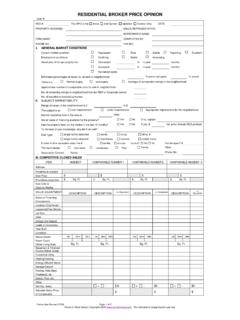Transcription of Square Footage Guidelines, Residential - Realty Plus, Inc.
1 Residential Square Footage guidelines Introduction It is often said that the three most important factors in making a home buying decision are "location," "location," and "location." Other than "location," the single most-important factor is probably the size or " Square Footage " of the home. Not only is it an indicator of whether a particular home will meet a homebuyer's space needs, but it also affords a convenient (though not always accurate) method for the buyer to estimate the value of the home and compare it with other properties. Although real estate agents are not required by the Real Estate License Law or Real Estate Commission rules to report the Square Footage of properties offered for sale (or rent), when they do report Square Footage , it is essential that the information they give prospective purchasers be accurate.
2 At a minimum, information concerning Square Footage should include the amount of living area in the dwelling. The following guidelines and accompanying illustrations are designed to assist real estate brokers and salespersons in measuring, calculating and reporting (both orally and in writing) the living area contained in detached and attached single-family Residential buildings. When reporting Square Footage , real estate agents should carefully follow these guidelines or any other standards that are comparable to them, including those approved by the American National Standards Institute, Inc. (ANSI) which are recognized by the North Carolina Real Estate Commission as comparable standards.* Agents should be prepared to identify, when requested, the standard used. Living Area Criteria Living area (sometimes referred to as "heated living area" or "heated Square Footage ") is space that is intended for human occupancy and is: 1.
3 Heated by a conventional heating system or systems (forced air, radiant, solar, etc.) that are permanently installed in the dwelling (not a portable heater) which generates heat sufficient to make the space suitable for year-round occupancy; 2. Finished, with walls, floors and ceilings of materials generally accepted for interior construction ( , painted drywall/sheet rock or panelled walls, carpeted or hardwood flooring, etc.) and with a ceiling height of at least seven feet, except under beams, ducts, etc. where the height must be at least six feet four inches [Note: In rooms with sloped ceilings ( , finished attics, bonus rooms, etc.) you may also include as living area the portion of the room with a ceiling height of at least five feet if at least one-half of the finished area of the room has a ceiling height of at least seven feet.]
4 ]; and 3. Directly accessible from other living area (through a door or by a heated hallway or stairway). Real estate appraisers and lenders generally adhere to more detailed criteria in arriving at the living area or "gross living area" of Residential dwellings. This normally includes distinguishing "above-grade" from "below-grade" area, which is also required by many multiple listing services. "Above-Grade" is defined as space on any level of a dwelling which has living area and no earth adjacent to any exterior wall on that level. "Below-Grade" is space on any level which has living area, is accessible by interior stairs, and has earth adjacent to any exterior wall on that level. If earth is adjacent to any portion of a wall, the entire level is considered "below-grade." Space that is "at" or "on grade" is considered "above-grade." While real estate agents are encouraged to provide the most complete information available about properties offered for sale, the guidelines recognize that the separate reporting of "above-grade" and "below-grade" area can be impractical in the advertising and marketing of homes.
5 For this reason, real estate agents are permitted under these guidelines to report Square Footage of the dwelling as the total "living area" without a separate distinction between "above-grade" and "below-grade" areas. However, to help avoid confusion and concern, agents should alert purchasers and sellers that the appraisal report may reflect differences in the way living area is defined and described by the lender, appraiser, and the North Carolina Building Code which could affect the amount of living area reported. Determining whether an area is considered living area can sometimes be confusing. Finished rooms used for general living (living room, dining room, kitchen, den, bedrooms, etc.) are normally included in living area. For other areas in the dwelling, the determination may not be so easy. For example, the following areas are considered living area if they meet the criteria ( , heated, finished, directly accessible from living area): Attic, but note in the listing data that the space is located in an attic.
6 [Note: If the ceiling is sloped, remember to apply the "ceiling height" criteria.] Basement (or "Below-Grade"), but note in the listing data that the space is located in a basement or "below-grade". [Note: For reporting purposes, a "basement" is defined as an area below the entry level of the dwelling which is accessible by a full flight of stairs and has earth adjacent to some portion of at least one wall above the floor level.] Bay Window, if it has a floor, a ceiling height of at least seven feet, and otherwise meets the criteria for living area. Bonus Room ( , Finished Room over Garage). [Note: If the ceiling is sloped, remember to apply the "ceiling height" criteria.] Breezeway (enclosed). Chimney, if the chimney base is inside living area. If the chimney base is outside the living area but the hearth is in the living area, include the hearth in the living area but not the chimney base.
7 Closets, if they are a functional part of the living area. Dormers Furnace (Mechanical) Room Also, in order to avoid excessive detail, if the furnace, water heater, etc. is located in a small closet in the living area, include it in living area even if it does not meet other living area criteria. Hallways, if they are a functional part of the living area. Laundry Room/Area. Office. Stairs, if they meet the criteria and connect to living area. Include the stairway with the area from which it descends, not to exceed the area of the opening in the floor. If the opening for the stairway exceeds the length and width of the stairway, deduct the excess open space from the upper level area. Include as part of the lower level area the space beneath the stairway, regardless of its ceiling height. Storage Room - Other Area Note in the listing data and advise purchasers of any space that does not meet the criteria for living area but which contributes to the value of the dwelling; for example, unfinished basements, unfinished attics (with permanent stairs), unfinished bonus rooms, shops, decks, balconies, porches, garages and carports.
8 Helpful Hints Concealed in the walls of nearly all Residential construction are pipes, ducts, chases, returns, etc. necessary to support the structure's mechanical systems. Although they may occupy living area, to avoid excessive detail, do not deduct the space from the living area. When measuring and reporting the living area of homes, be alert to any remodeling, room additions ( , an enclosed porch) or other structural modifications to assure that the space meets all the criteria for living area. Pay particular attention to the heating criteria, because the heating system for the original structure may not be adequate for the increased Square Footage . Although agents are not required to determine the adequacy of heating systems, they should at least note whether there are heat vents, radiators or other heat outlets in the room before deciding whether to include space as living area.
9 When an area that is not part of the living area ( , a garage) shares a common wall with the living area, treat the common wall as the exterior wall for the living area; therefore, the measurements for the living area will include the thickness of the common wall, and the measurements for the other area will not. Interior space that is open from the floor of one level to the ceiling of the next higher level is included in the Square Footage for the lower level only. However, any area occupied by interior balconies, lofts, etc. on the upper level or stairs that extend to the upper level is included in the Square Footage for the upper level. Measurements The amount of living area and "other area" in dwellings is based upon exterior measurements. A one hundred-foot-long tape measure is recommended for use in measuring the exterior of dwellings, and a thirty-foot retractable tape for measuring interior and hard-to-reach spaces.
10 A tape measure that indicates linear Footage in "tenths of a foot" will greatly simplify your calculations. For best results, take a partner to assist you in measuring. But if you do not have someone to assist you, a screwdriver or other sharp tool can be used to secure the tape measure to the ground. Begin at one corner of the dwelling and proceed with measuring each exterior wall. Round off your measurements to the nearest inch (or tenth-of-a-foot if your tape indicates Footage in that manner). Make a sketch of the structure. Write down each measurement as you go, and record it on your sketch. A clipboard and graph paper are helpful in sketching the dwelling and recording the measurements. Measure living area and "other area," but identify them separately on your sketch. Look for offsets (portions of walls that "jut out"), and adjust for any "overlap" of exterior walls or "overhang" in upper levels.









